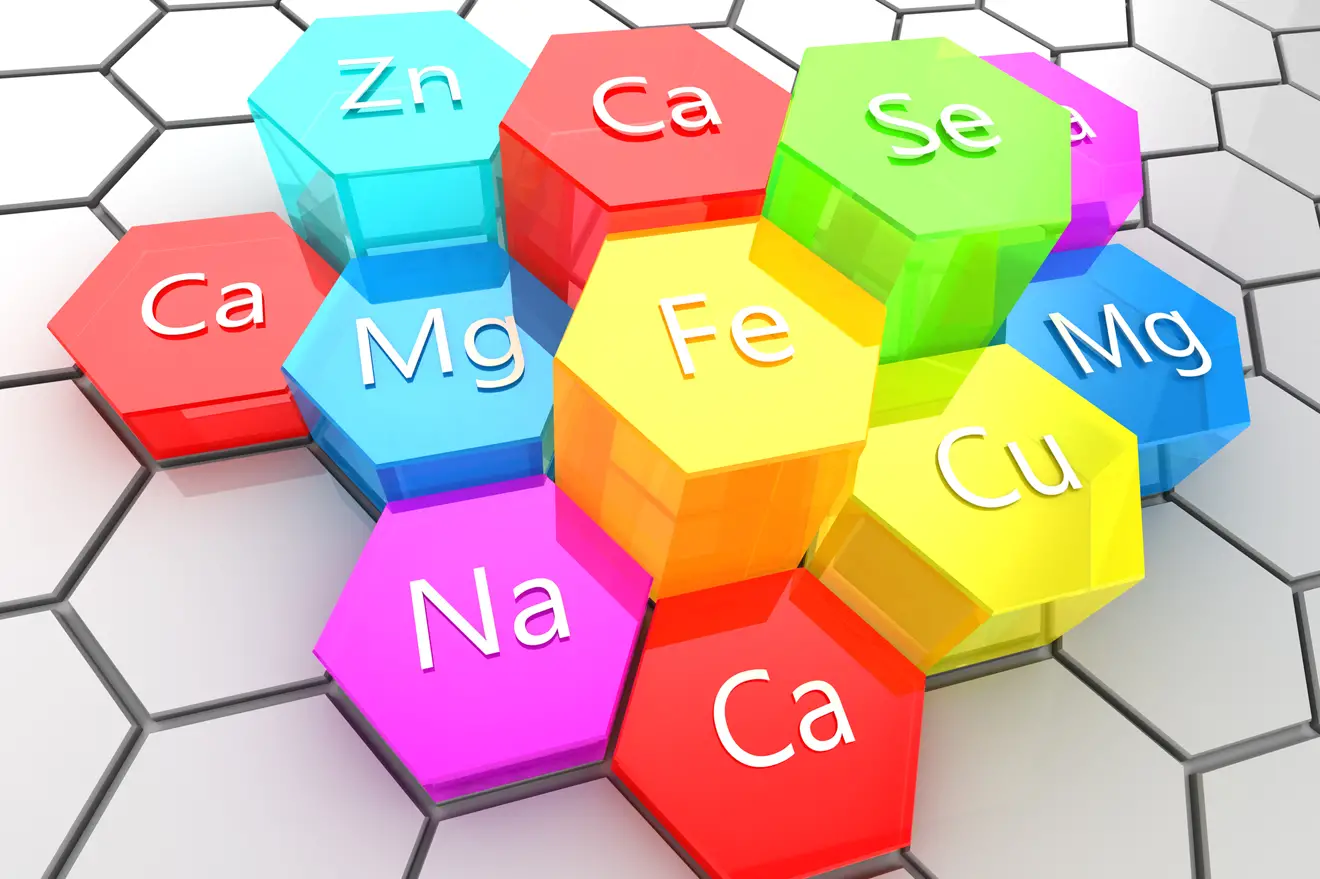Dietary minerals
What are dietary minerals?
Dietary minerals are inorganic chemical elements that your body needs for proper health, growth, and function. Along with vitamins, dietary minerals are known as micronutrients because they are needed by the body in small amounts. Macronutrients, in comparison (which include protein, carbohydrate, and fat), are needed in large amounts.
Your body uses minerals for many different jobs, including building bones and making hormones. You can get all of the dietary minerals you need from your diet, as long as it is balanced, nutrient-dense, and diverse. If you do not consume enough of a certain mineral, you may suffer from health problems. Mineral deficiencies can be fixed by modifying your diet or taking a supplement. Before taking a supplement, speak to your doctor. You can also suffer from health problems if you get too much of a mineral.
Types of dietary minerals
Dietary minerals are classified into two groups based on how much your body needs:
- Macrominerals
- Trace minerals
Macrominerals are minerals your body needs in relatively large amounts. They include:
- Calcium
- Potassium
- Magnesium
- Phosphorus
- Sodium
- Chloride
- Sulfur
Trace minerals are minerals your body needs in relatively small amounts. They include:
- Iron
- Manganese
- Copper
- Iodine
- Zinc
- Selenium
- Chromium
- Fluoride
According to the USDA, adult Americans typically do not get enough calcium and especially potassium, both of which are considered public health concerns.
Macrominerals
Calcium
Calcium (Figure 1) is the most abundant mineral in your body. Your body needs calcium to build strong bones and teeth and to maintain strong and healthy bones. The following foods are good sources of calcium:
- Low-fat yogurt, cheese, and milk
- Fishes, such as sardines, pink salmon, and ocean perch
- Beans, such as soybeans and white beans
- Spinach
- Oatmeal
Figure 1. Sources of calcium.
Potassium
Potassium is a very important dietary mineral, used by your body to build proteins (and therefore muscle), maintain normal body growth, break down carbohydrates, control the electrical activity of your heart, and maintain a healthy blood pressure. Good sources of potassium include:
- Fishes, such as halibut, yellowfin tuna, rockfish, and cod
- Beans, such as white beans, soybeans, lima beans, and kidney beans
- Milk and dairy products, such as yogurt
- Sweet and regular potatoes
- Fruits, such as bananas, peaches, cantaloupe, and honeydew melons
- Tomato paste, puree, juice, and sauce
Magnesium
Magnesium helps your body to produce energy, and it helps your muscles, arteries, and heart to work properly. Good sources of magnesium are:
- Vegetables, such as pumpkin, spinach, and artichoke
- Bran cereal
- Beans, such as soybeans, white beans, black beans, navy beans, and great northern beans
- Tofu
- Brown rice
- Nuts, such as brazil nuts, almonds, cashews, and peanuts
Phosphorus
After calcium, phosphorus (Figure 2) is the second most abundant mineral in your body. Your body needs phosphorus for a variety of purposes, such as building strong bones and teeth, filtering waste from your kidneys, managing the usage and storage of energy, repairing tissues, ensuring proper nerve signaling, and utilizing certain vitamins and minerals (vitamin B, vitamin D, iodine, magnesium, and zinc). In the context of weight training and exercise, phosphorus is important for assisting muscle contraction and reducing muscle soreness after exercise.
Figure 2. Food sources of phosphorus.
Most foods contain phosphorus. As a result, you’re more likely to get too much than too little. Foods that are rich in protein are also usually rich in phosphorus. These include:
- Meats and poultry
- Fishes
- Milk and dairy products
- Eggs
- Nuts and seeds
- Beans
Sodium
Sodium is important for controlling the balance of fluid in your body and maintaining your blood volume and blood pressure. The problem is that you may already be getting too much, which could lead to high blood pressure and fluid retention.
The main source of sodium for most people is table salt (sodium chloride). The average American takes in five or more teaspoons of table salt per day, when, in fact, only one quarter of a teaspoon is needed. Sodium also naturally occurs in foods, and a lot of it is often artificially added to foods during processing and preparation. Large amounts can be found in canned and fast foods.
Chloride
Chloride is needed to control the balance of bodily fluids and is an essential part of digestive juices. As with sodium, it is consumed, often in excess, mainly though table salt. Getting too much chloride from salted foods can lead to high blood pressure and fluid retention. Chloride also occurs naturally in many vegetables. Foods with high amounts of chloride include:
- Seaweed
- Rye
- Tomatoes
- Lettuce
- Celery
- Olives
Sulphur
Sulphur helps your body to resist bacteria and protect against toxic substances. It is also necessary for proper development of connective tissues and helps skin maintain structural integrity. Good sources of sulphur include:
- Cruciferous vegetables, such as cauliflower, Brussels sprouts, broccoli, kale, cabbage, and turnips
- Allium vegetables, such as garlic, onions, leeks, and chives
- Meats, such as beef, fish, and poultry
- Nuts
- Legumes
- Egg whites
Trace minerals
Iron
Iron (Figure 3) is important for the production of proteins called hemoglobin and myoglobin. The former is found in red blood cells, whereas the latter is found in muscle cells. Hemoglobin and myoglobin are very important because they bind to oxygen, carry it around your body, and deliver it to cells. Iron also supports immune function, temperature regulation, and brain development.
Figure 3. Sources of iron.
There are two types of dietary iron: heme and non-heme. Heme iron is derived from hemoglobin, which means that it comes from animal sources that originally contained hemoglobin. Non-heme iron comes from plant sources. Heme iron is absorbed by your body more readily than is non-heme iron. Great sources of heme iron include:
- Meats, such as beef, turkey, chicken, ham, beef liver, and chicken liver
- Shellfish, such as clams, mussels, and oysters
- Fishes, such as sardines, halibut, haddock, perch, salmon, and tuna
Manganese
Manganese is required for the production of bones, connective tissues, skin, and sex hormones. It’s also used for the regulation of blood sugar, the absorption of calcium, and the breakdown of dietary fats and carbohydrates. Foods high in manganese include:
- Seafood, such as mussels, clams, and crayfish
- Nuts, such as hazelnuts, walnuts, macadamia, cashew nuts, and almonds
- Seeds, such as sesame seeds, flaxseeds, and sunflower seeds
- Whole-wheat bread
- Tofu
- Beans, such as butter beans, winged beans, chickpeas, adzuki beans, and white beans
- Fishes, such as bass, pike, and perch
- Spinach
- Brown rice
Copper
Copper is needed by your body to produce bones, connective tissues, enzymes, and important neurotransmitters. In order to absorb copper, your stomach has to be acidic. As such, antacids can interfere with the absorption of copper, as can milk and egg proteins. Good sources of copper include:
- Seafood, such as oysters, lobsters, crabs, and octopuses
- Raw kale
- Mushrooms
- Various seeds, such as sesame seeds, pumpkin seeds, squash seeds, and flaxseeds
- Nuts, such as hazelnuts, brazil nuts, cashew nuts, walnuts, pine nuts, and pistachio nuts
- Beans, such as soybeans, adzuki beans, kidney beans, and white beans
- Dried fruits, such as apricots, currents, peaches, raisins, and figs
- Avocados
Iodine
The only cells in your body that absorb iodine are in you thyroid. Your thyroid uses iodine to produce two hormones: triiodothyronine (T3) and thyroxine (T4). T3 and T4 are primarily responsible for the regulation of your metabolism, which makes them extremely important. A lack of iodine in your diet can lead to a decreased production of T3 and T4. Although vital, your body only needs 150 micrograms (one-20,000th of a teaspoon) of iodine per day. Common sources of iodine include:
- Dairy products, such as cheese, cow’s milk, yogurt, ice cream
- Seaweed, including kelp, dulce, and nori
- Saltwater fish
- Shellfish
- Eggs
- Iodized table salt
- Soy milk and soy sauce
Zinc
Zinc is found throughout your body. It is required for maintaining a proper sense of taste and smell and helps your immune system to fight invading bacteria and viruses. Your body also needs zinc to make proteins and DNA and to aid in the process of wound repair.
Zinc is found in a variety of foods. Rich sources include:
- Oysters, which are the best source of zinc
- Other seafood, such as crabs and lobsters
- Meats, such as beef, lamb, pork, chicken, and poultry
- Wheat germ
- Spinach
- Seeds, such as pumpkin seeds and squash seeds
- Nuts, such as cashew nuts, pecan nuts, pine nuts, almonds, walnuts, and peanuts
- Cocoa and chocolate (yippee!)
- Beans, such as chickpeas, baked beans, adzuki beans, and kidney beans
Selenium
Selenium is required by the body for proper thyroid gland function. It is also used to produce selenoprotein antioxidants, which are compounds that protect your cells from damage caused by negatively charged particles. High-selenium foods include:
- Nuts, such as brazil nuts, cashew nuts, black walnuts, and macadamia nuts
- Seafood, such as oysters, mussels, octopuses, squids, lobsters, and clams
- Fishes, such as tuna, rockfish, swordfish, halibut, tilapia, mackerel, and snapper
- Whole-wheat bread
- Seeds, such as sunflower seeds, chia seeds, sesame seeds, flaxseeds, and pumpkin seeds
- Meats, such as pork, beef, lamb, chicken, and turkey
- Mushrooms
- Whole grains, such as brown rice and rye
Chromium
Chromium is an important dietary mineral for your body’s metabolism. It enhances the action of insulin, the hormone responsible for allowing the glucose in your blood to enter your cells, providing them with the energy that they need to function. Good sources of chromium include:
- Meats, such as beef and turkey
- Vegetables, such as broccoli, potatoes, and basil
- Fruits, such as apples, grapes, and bananas
- Red wine
- Green beans
- Garlic
- Whole-wheat bread
Fluoride
Fluoride can be found naturally in your body as calcium fluoride, which mostly occurs in your bones and teeth. You only need a small amount of fluoride each day to keep your bones strong and to prevent tooth decay.
Fluoride can be obtained in two ways: topically and systemically. Topical fluoride sources include toothpastes and mouthwashes, which are used to strengthen teeth that are already formed in your mouth. Systemic fluorides are those that are ingested, usually through drinking water, and become incorporated into developing teeth and bones.
The fluoride content of foods is very low. Fluoride has been added to the US water supply since the 1960s. If you brush your teeth with fluoride toothpaste and live in an area where the water has been fluoridated, you most likely get more than enough fluoride.










